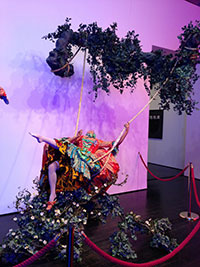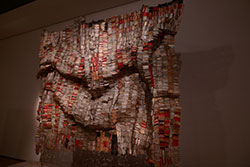Global Contemporary
AP Art History Global Contemporary Resources
Recommended reading(s)
(many of these books have short sections on the artists included the curriculum):
- Heartney, Eleanor. Art & Today, (London: Phaidon, 2008).
- Kalb, Peter R. Art Since 1980: Charting the Contemporary, (Pearson, 2014).
- Kahn Academy, AP Art History: Global Contemporary: 1980-present.
- PBS, Art 21, 2001
- Smith, Terry. Okwui Ewezor and Nancy Condee eds. Antinomies of Art and Culture: Modernity, Postmodernity, and Contemporary, (Duke U, 2008). Note from Sarah Hollenberg: This collection of essays is more challenging than the rest of the material on this list—it would more likely be helpful for you in developing depth in your course materials, than it would be for students—but compared to the others it is far more global in its scope, featuring excellent and informed discussions of contemporary African and Chinese art in particular.
- Stallabrass, Julian. Art Incorporated: The Story of Contemporary Art, (Oxford UP, 2004).
- Thornton, Sarah. 33 Artists in Three Acts. (New York, 2014).
Recommended reading(s)
Abramson, Daniel. “Maya Lin and the 1960s: Monuments, Time Lines, and Minimalism” Critical Inquiry, 22, no. 4 (Summer, 1996), 679-709
Marling, Karal Ann and Robert Silberman, “The Statue near the Wall: The Vietnam Veterans Memorial and the Art of Remembering” Smithsonian Studies in American Art, vol. 1, no. 1 (Spring, 1987), 4-29.
Note from Sarah Hollenberg: Regarding the relationship between Lin’s monument and the three soldiers that were added, I noticed when I was in DC that Frederick Hart’s Three Soldiers are looking at the monument, which isn’t obvious from photographs.
Recommended reading(s)
Neave, Dorinda, Lara C. W. Blanchard, and Marika Sardar. Asian Art. Upper Saddle River, N.J.: Pearson, 2014, 270-271.
Kee, Joan. “The Curious Case of Contemporary Ink Painting.” Art Journal, 69:3 (Fall 2010), 88-113. Article
Recommended reading(s)
Ames, Roger T., Hsingyuan Tsao, Xu Bing and Contemporary Chinese Art: Cultural and Philosophical Reflections, (SUNY Press), 2011.
Bing, Xu., Janelle S. Taylor “Non-Sense in Context: Xu Bing’s Art and its Publics” Public Culture, (1993), 317-327. (interview).
Neave, Dorinda, Lara C. W. Blanchard, and Marika Sardar. Asian Art. Upper Saddle River, N.J.: Pearson, 2014, 235.
Erickson, Britta and Xu Bing. Words Without Meaning, Meaning Without Words: The Art of Xu Bing. Seattle: University of Washington Press, 2001. Worldcat.
Stone, Charles. “Xu Bing and the Printed Word” Public Culture, 6, no. 2 (1994), 407-410.
[Nam June Paik. 1995 C.E. Mixed-media installation (49-channel closed-circuit video installation, neon, steel, and electronic components).]
Recommended reading(s)
Hanhardt, John G. “Nam June Paik (1932-2006): Video Art Pioneer” American Art, vol. 20, no. 2 (2006).
London, Barbara. “Time as Medium: Five Artists’ Video Installations” Leonardo, vol. 28, No. 5, (1995).
Serwer, Jacquelyn D. “Nam June Paik: ‘Technology’” American Art, vol. 8, no. 2 (Spring, 1994), 87-91.
Smith, Walter. “Nam June Paik’s TV Buddha as Buddhist Art” Religion and the Arts, vol. 4, issue 3, (September 2000).
Note from Sarah Hollenberg: DC is represented by a cluster of very small screens on a closed-circuit feed, so you see yourself in them as you approach. The continental US occupies almost all of the wall it is on, with the southernmost states folding under at the floor, and Hawaii and Alaska on the wall to the left. Sound comes from selected screens. The screen featuring Alabama alternates between speeches by MLK and Malcolm X, and this is one of the clearest lines of audio (mostly, you hear a cacophony of layered noise). Interestingly, Utah is represented by one of the only feeds taken with a portable video camera (most of the screens play appropriated film or television footage, or works by Paik that have been “processed” or abstracted with special effects), which includes footage of the salt flats, open road, and some goats. Arkansas is mostly Bill and Hillary Clinton, with some footage of Paik’s sometime collaborator Charlotte Moorman playing Paik’s TV Cello
Recommended reading(s)
Jewett, Jamie. “Seeing the Mind, Stopping the Mind: The Art of Bill Viola” International Journal of Performance Arts & Digital Media, vol4, issue 1 (2008).
London, Barbara. “Time as Medium: Five Artists’ Video Installations” Leonardo, vol. 28, No. 5, (1995).
Viola, Bill and Caridad Svich “’A Process of Perception’: A Conversation with Bill Viola” Contemporary Theatre Review, vol. 14, issue 2 (2004).
Recommended reading(s)
Ippolito, J. M. “Words, Images and Avatars: Explorations of Physical Place and Virtual Space by Japanese Electronic Media Artists” Leonardo, 42, no. 5 (2009), 421-426, 395.
Miko no Inori / Shaman-Girl’s Prayer (1996). Video link.
Molon, Dominic. Mariko Mori. Chicago: Museum of Contemporary Art, 1998. Worldcat.
Moriko, M. and Kunie Sigura “Interview with Moriko Mori” Journal of Contemporary Art Online, N/D, (jca-online.com/mori).
Shanks, Gwyneth. “Visualizing the Now: The Alien, the Island and Mariko Mori’s Beginning of the End”Third Text, vol. 28, nos-4-5.
Journey to Seven Light Bay (2011): Video link.
Recommended reading(s)
Enwezor, Okwui and Hal Foster, “Questionnaire on the Contemporary” in October, vol. 130 (Fall, 2009), 33-40.
Felsenthal, Julia. “The Curious History of ‘Tribal’ Prints” Slate, (March, 2012).Read Article at Slate.com
Hynes, Nancy and John Picton “Yinka Shonibare” African Arts, vol. 34, no. 3 (Autumn, 2001), 60-73, 93-95.
Recommended reading(s)
Binder, Lisa M. “El Anatsui: Transformations” African Arts, vol. 41, no. 2 (Summer, 2008), 24-37.
Oguibe, Olu. “El Anatsui: Beyond Death and Nothingness” African Arts, vol. 31, no. 1 (Winter, 1998), 48-55.
Note from Sarah Hollenberg: While Anatsui’s work is usually discussed in relation to sculpture and textiles, the National Museum of African Art has one of his wall works on display next to an array of West African (mostly Wolof) filigree gold jewelry, which brought Anatsui’s success in transforming literal trash into something that has the appearance of preciousness into sharp relief. It framed his practice as a sort of contemporary alchemy—spinning gold out of aluminum and copper (you can see the untitled work here).
Recommended reading(s)
Adan, Elizabeth. “An ‘Imperative to Interrupt’: Radical Aesthetics, Global contexts and Site-Specificity in the Recent Work of Doris Salcedo” Third Text, vol. 24, Issue 5, 2010.
Alzate, Gastón and Marcia Olander. “Absence and Pain in the Work of Doris Salcedo and Rosemberg Sandoval” South Central Review, vol. 30, no. 3 (Fall 2013), 5-20.
Bal, Mieke. Of What One Cannot Speak: Doris Salcedo’s Political Art, (U Chicago Press, 2010).
“Compassion: Doris Salcedo,” ART21-Art in the Twenty-First Century, Season 5. Public Broadcasting Service (PBS), 2009. Accessed April 23, 2015. PBS.
Doris Salcedo: Shibboleth. (exhibition catalog) London: Tate Publishing, 2007. Worldcat.
“Doris Salcedo: Shibboleth,” Tate Modern, 2007. Accessed April 23, 2015. Link.
“The Unilever Series: Doris Salcedo: Shibboleth,” Tate Modern, 2007. Accessed April 23, 2015. Video.
Video - María del Mar González-González lecture 2015
Recommended reading(s)
Klayman, Alison and Ai Wiewei, Ai Weiwei: Never Sorry, 2012. (film available on Netflix.)
Neave, Dorinda, Lara C. W. Blanchard, and Marika Sardar. Asian Art. Upper Saddle River, N.J.: Pearson, 2014, 236.
Sorace, Christian. “China’s Last Communist: Ai Weiwei” Critical Inquiry, vol. 40, no. 2 (2014), 396-419.
Smith, Karen, Hans Ulrich Obrist, and Bernhard Fibicher. Ai Weiwei. London: Phaidon, 2009. Worldcat.
Zheng Bo. “From Gongren to Gongmin: A Comparative Analysis of Ai Weiwei’s Sunflower Seeds and Nian.” Journal of Visual Art Practice, 11:2/3 (2012), 118-132. Article.
The Tate Modern’s exhibition guide to the installation. Click this link.
No public domain image available
[Faith Ringgold. 1991 C.E. Acrylic on canvas, tie-dyed, pieced fabric border.]
Recommended reading(s)
Millman, Joyce. “Faith Ringgold’s Quilts and Picturebooks: Comparisons and Contributions” Children’s Literature in Education, vol. 36, issue 4 (December 2004), 381-393.
Priest, Myisha. “Gospels according to Faith: Rewriting Black Girlhood through the Quilt” Children’s Literature Association Quarterly, (Winter, 2014), vol. 39, no. 4), 461-481.
Ringgold, Faith and Dan Cameron, Dancing at the Louvre: Faith Ringgold’s French Collection and Other Story Quilts, (New Museum, NYC: 1998).
No public domain image available
[Jaune Quick-to-See Smith. 1992 C.E. Oil and mixed media on canvas.]
Recommended reading(s)
Kastner, Carolyn. “Jaune Quick-to-See Smith: Indingenous Bodies, Indigenous Stories in a Post-Columbian World” in Indigenous Bodies: Reviewing, Relocating, Relaiming, eds R. Tillett and J. Fear-Segal, (State University of New York Press, 2013), 3-16
King, Thomas. The Inconvenient Indian: A Curious Account of Native People in North America, (University of Minnesota Press, 2013).
Paul Chaat Smith “Home of the Brave” in Everything You Know About Indians is Wrong, (U of Minnesota Press, 2009).
AIM Position Paper: http://www.aimovement.org/ggc/trailofbrokentreaties.html
No public domain image available
[Shirin Neshat. 1994 C.E. Ink on photograph. Photo by Cynthia Preston.]
Recommended reading(s)
Dadi, Iftikhar. “Shirin Neshat’s Photographs as Postcolonial Allegories” Signs, vol. 34, no. 1 (Autumn, 2008), 125-150.
Neshat, Shirin and Scott MacDonald, “Between Two Worlds: An Interview with Shirin Neshat” Feminist Studies, vol. 30, no. 3 (Fall, 2004), 620-659.
Neshat, Shirin. Rapture, 1999. (vimeo.com/65972620).
Note from Sarah Hollenberg: Someone documented one of Neshat’s more powerful installations and shared the documentation on vimeo. The quality is very poor, but in combination with the photographic work, and Turbulent (the video we watched during the workshop) it will give you a clearer sense of the aesthetics of her practice. The music will be familiar to you—it is by Sussan Deyhim, the performer/composer in Turbulent (and Rapture’s credits tell us that she was indeed working with Inuit throat singers!).
No public domain image available
[Kara Walker. 2001 C.E. Cut paper and projection on wall.]
Recommended reading(s)
Raymond, Yasmil. “Maladies of Power: A Kara Walker Lexicon” in Kara Walker: My Compliment, My enemy, My Oppressor, My Love, (Walker Art Center, 2007).
Wall, David. “Transgression, Excess, and the Violence of Looking in the Art of Kara Walker” Oxford Art Journal, 33.3 (2010), 277-299.
No public domain image available
[Wangechi Mutu. 2006 C.E. Mixed media on Mylar.]
Recommended reading(s)
Bourland, W. Ian. “Wangechi Mutu Hunt Bury Flee” (review), Nka: Journal of Contemporary African Art, no. 28 (2011), 156-159.
Mutu, Wangechi. “Artist Statement” Callaloo, vol. 37, no. 4 (Fall, 2014), 921-928.
Schoonmaker, Trevor. “Wengechi Mutu: A Fantastic Journey” Nka: Journal of Contemporary African Art, Number 35, (Fall, 2014), 42-53.












